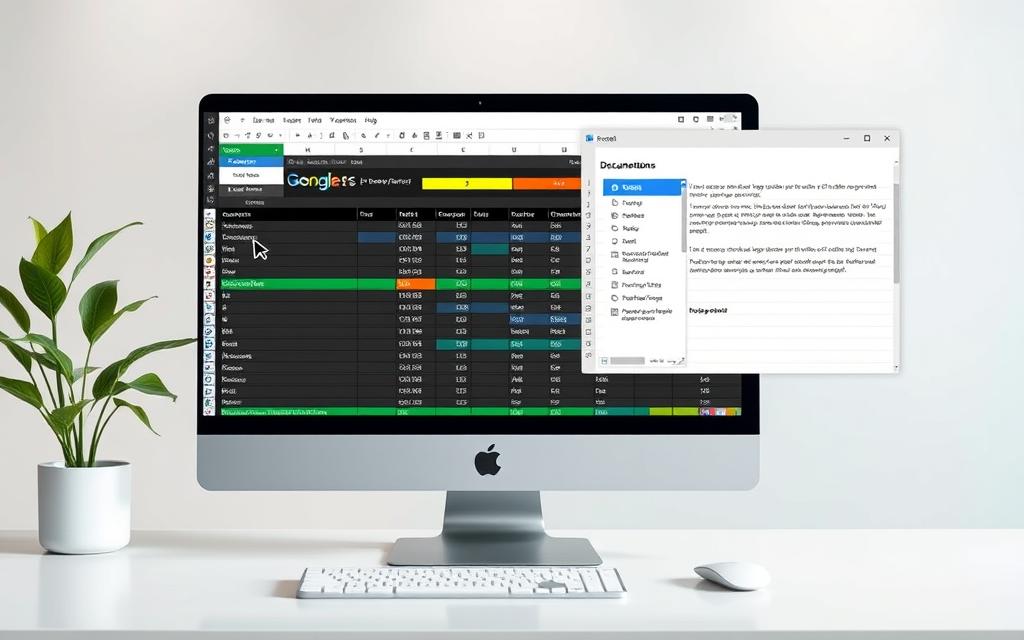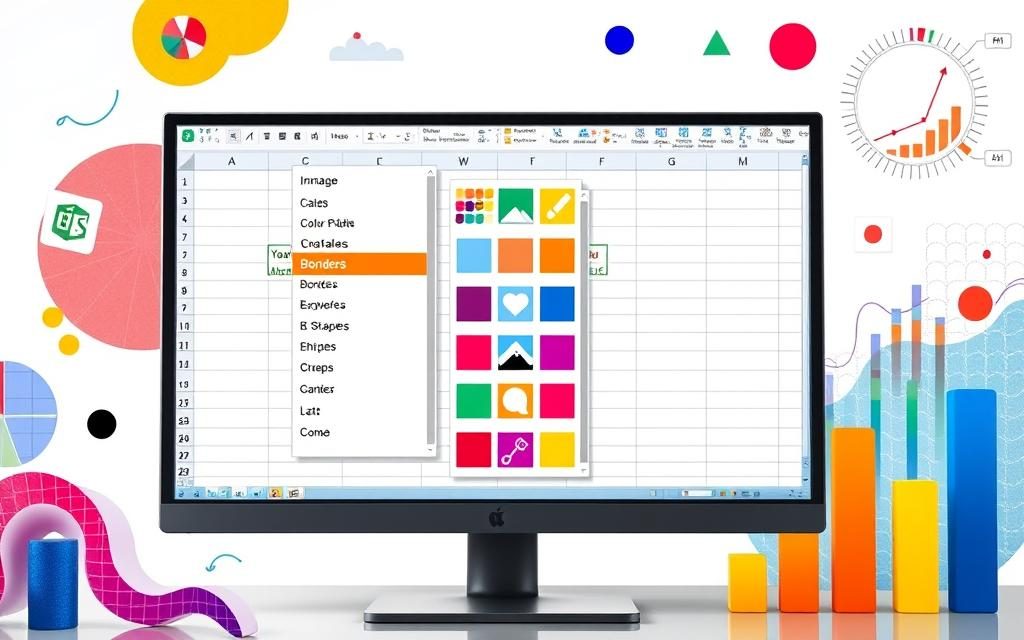
Are you tired of making mistakes when you enter data? Do you spend too much time on spreadsheets? There’s a way to make your Excel work easier with one key feature.
Drop-down lists in Excel are amazing tools. They change how we handle data. These menus make your spreadsheets better and easier to use.
In this guide, we’ll show you how to make drop-down lists. They will change how you enter data. This tip is great for anyone who uses Excel, whether you’re in business, school, or work.
Key Takeaways
- Drop-down lists make data more accurate
- Excel has many ways to make lists
- Data validation stops wrong entries
- Custom lists are easy to make
- Drop-down menus make spreadsheets better
What is a Drop Down List in Excel?
Excel drop-down lists are powerful tools for making spreadsheets better. They let creators control what users can type in. This makes data entry easier and more accurate.
At its core, an Excel drop-down list is a way to enter information. It shows users a menu of choices they can pick from. This helps avoid mistakes and keeps data the same across spreadsheets.
Definition of Drop-Down Lists
A drop-down list in Excel is a special cell feature. It shows a menu of choices when you click an arrow. This stops typing mistakes and keeps data right.
Benefits of Using Drop-Down Menus
- Improves data validation by restricting input to specific choices
- Reduces human error in data entry processes
- Speeds up spreadsheet completion time
- Creates a standardized data collection method
Drop-down menus do more than just stop mistakes. They help keep data clean and the same in many places.
| Feature | Benefit |
|---|---|
| Predefined Options | Eliminates incorrect data entry |
| User Guidance | Provides clear input instructions |
| Efficiency | Reduces time spent on data management |
Using drop-down lists makes Excel spreadsheets smarter. They help make data entry faster and more accurate.
Getting Started with Excel
Excel is a powerful tool for managing and analyzing data. For beginners, it’s key to learn the basics first. This will help you use Excel features well and work more efficiently.

Opening Excel and Creating a New Spreadsheet
To start your Excel journey, just follow these steps:
- Launch Microsoft Excel from your desktop or start menu
- Click on “Blank workbook” to create a new spreadsheet
- Get to know the default blank worksheet
Navigating the Ribbon Interface
The ribbon is your main tool for using Excel features. Here’s a quick look at the main parts:
| Ribbon Tab | Primary Functions |
|---|---|
| Home | Basic formatting, editing, and cell management |
| Insert | Adding charts, tables, and other visual elements |
| Data | Data validation, sorting, filtering, and list creation |
| Formulas | Creating complex calculations and functions |
For beginners, the Data tab is very important. It helps with creating drop-down lists and managing data validation. Each section of the ribbon has special tools to improve your spreadsheets.
Keep practicing to get better at using Excel. Learning the basics is the first step to using Excel’s advanced features.
Preparing Your Data for a Drop Down List
Getting your Excel data ready is key for drop-down lists. It makes inputting data smooth and cuts down on mistakes.
Before making a drop-down list, organize your data well. You need a clean, organized list of choices. This list will be the base of your drop-down menu.
Creating a List of Options
Here’s how to get your drop-down options ready:
- Pick one worksheet for your list
- Put items vertically in one column
- Make sure there are no duplicates
- Don’t leave any blank cells
Organizing Your Data in a Single Column
Organizing your options in Excel makes input easier. Here’s the best way to set up your list:
| Column Location | Best Practice |
|---|---|
| Same Worksheet | Quick and easy for small lists |
| Separate Worksheet | Great for big, complex lists |
| Different Workbook | Good for shared or reference data |
Pro tip: Keep your list clean and simple. Get rid of extra spaces or special characters. They can mess up your drop-down list.
By following these tips, you’ll make a great drop-down list in Excel. It will be easy to use and efficient.
How to Create a Drop Down List
Excel drop-down lists make data entry easier and cut down on mistakes. They help keep your spreadsheets consistent with little effort.

Creating a drop-down list in Excel is easy. Even beginners can do it fast.
Preparing for Drop-Down List Creation
Start by getting your data ready. Put all your options in one column. This makes it easier to set up.
Step-by-Step Data Validation Process
- Open your Excel spreadsheet
- Select the cell where you want your drop-down list
- Go to the Data tab in the ribbon
- Click on Data Validation
- Pick “List” from the Allow dropdown
- Type in your list items in the Source field
- Use commas to separate items
- Or pick a cell range with your options
- Hit OK to make your drop-down list
Customizing Your Drop-Down List
Excel lets you customize your data validation. You can add alerts, limit choices, and more. This makes your list work just how you need it.
By following these steps, you’ll get good at making Excel drop-down lists. Your spreadsheets will be more useful and easy to use.
Customizing Your Drop Down List
Excel drop-down customization makes your spreadsheets better. It makes data entry easier and less likely to have mistakes.

Modifying Drop Down Options
You can change your drop-down lists in many ways:
- Edit the source data directly in the original range
- Use Data Validation settings to update the list
- Add or remove items dynamically
Changing your Excel drop-downs keeps your data fresh. Users can update the list easily without starting over.
Adding Error Alerts in Excel
Error alerts in Excel help when users try to enter wrong data. To set these alerts up:
- Navigate to Data Validation dialog box
- Select the Error Alert tab
- Customize your error message
- Choose an appropriate alert style
Good error alerts stop mistakes and keep your spreadsheet right.
| Alert Type | Description | User Guidance |
|---|---|---|
| Stop | Prevents invalid entries | Blocks incorrect data completely |
| Warning | Allows confirmation of entry | Prompts user to verify unusual input |
| Information | Provides additional context | Offers helpful guidance without restricting entry |
Using these tips, you can make your Excel drop-down lists smarter and easier to use.
Using Named Ranges for Drop Down Lists
Excel named ranges make drop-down lists better. They save time and help manage data well. This makes spreadsheets easier to use and keep up.
Named ranges have big benefits. They help with Excel formulas and data checks. They make spreadsheets easier to handle by updating automatically.
Defining a Named Range
It’s easy to make a named range in Excel. Just follow these steps:
- Select the data range you want to name
- Click on the “Formulas” tab in the ribbon
- Choose “Define Name” in the “Defined Names” group
- Enter a unique name for your range
- Verify the selected cell range
Linking a Drop Down to a Named Range
After making a named range, you can link it to a drop-down list. This keeps your list up to date.
| Technique | Benefit |
|---|---|
| Excel Tables | Automatically expand when new rows are added |
| Named Ranges | Create dynamic drop-down lists that update with new values |
| Data Validation | Restrict entries to approved values |
Named ranges make drop-down lists better. They help keep data right and make spreadsheets work better. This is great when many people use the same worksheet.
How to Edit or Delete a Drop Down List
Managing drop-down lists in Excel is key for keeping data right and organized. You might need to change or get rid of drop-down lists. Excel has many ways to help you make your spreadsheets better.
Changing Items in Your List
To update a drop-down list, follow these steps:
- Find the source data for your drop-down list
- Pick the cells with the drop-down list
- Go to the Data Validation feature
- Change the source range or list of options
Removing the Drop Down Functionality
To remove Excel drop-down lists, you have a few options:
- Clear Data Validation:
- Pick the cells with the drop-down list
- Go to Data tab
- Choose Data Validation
- Click Clear All
- Modify Validation Settings:
- Open Data Validation dialog
- Change validation criteria to Allow Any Value
- Copy and Paste Method:
- Copy a blank cell
- Paste over cells with drop-down lists
Learning these methods lets you edit and update drop-down lists easily. You can make your Excel spreadsheets more flexible and precise.
Common Problems and Solutions
Excel drop-down lists can sometimes cause trouble. Knowing common issues and how to fix them helps keep data right and workflow smooth. Learning to solve Excel data validation problems is key.
Troubleshooting Drop Down Issues
Users often face several problems with Excel drop-down lists:
- List not updating automatically
- Circular references disrupting data validation
- Formatting inconsistencies
- Unexpected validation errors
To fix these issues, look closely at your data and cell references. Make sure the original data source is accurate and consistent.
Best Practices to Avoid Errors
To avoid Excel data validation problems, follow these tips:
- Use named ranges for better list management
- Keep source data up to date
- Make clear error messages for users
- Check input criteria carefully
| Problem | Solution |
|---|---|
| Outdated List Items | Implement dynamic named ranges |
| Multiple Selection Restrictions | Use advanced data validation settings |
| Input Errors | Add custom error alerts |
Being proactive and knowing how to troubleshoot Excel drop-down lists makes your spreadsheets better and easier to use.
Conclusion
Excel drop-down lists are very useful for managing data better. They help make spreadsheets more organized and less prone to mistakes. By using these tips, you can make your spreadsheets work better for you.
The Excel drop-down summary methods we talked about help keep data consistent. This makes it easier to avoid mistakes.
Summary of Key Steps
To make good drop-down lists, you need to know about data validation. You also need to organize your data well. Using Excel’s features is key.
Excel tips and tricks can make a big difference. Things like named ranges and custom validation rules help a lot. Also, learning about conditional formatting can change how you manage spreadsheets.
Exploring Advanced Features
When you try out advanced drop-down list techniques, you can do even more. Basic lists are easy, but learning VBA coding and making dynamic lists opens up more possibilities. Try new things and keep getting better at using Excel.
Getting good at Excel drop-down lists takes time and practice. Every project is a chance to learn and find new ways to use this tool.




